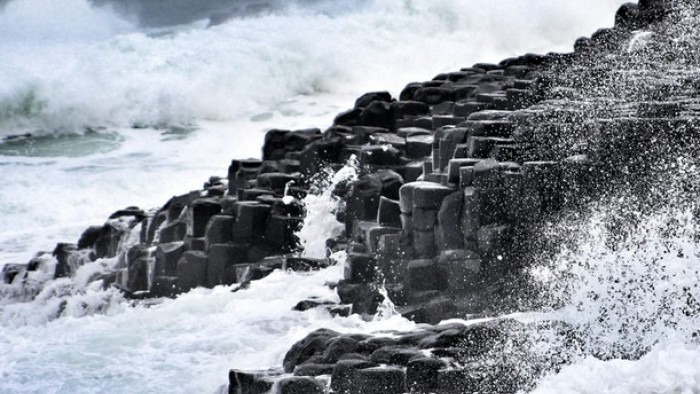Credit Suisse Conference Examines How Nature Reduces Risk - An Op-ed by Eric Letsinger

[[{"fid":"3780","view_mode":"default","fields":{"format":"default","field_file_image_alt_text[und][0][value]":"Giant's Causeway, Northern Ireland","field_file_image_title_text[und][0][value]":""},"type":"media","attributes":{"alt":"Giants Causeway, Northern Ireland","height":"286","width":"400","style":"float:right","class":"media-element file-default"}}]]Note: This op-ed covers an event cohosted by Conservation Finance Network.
From hurricanes to floods, earthquakes to landslides, and wildfires to monsoons, 2017 was far from normal. Nature made headlines again and again with devastating storm and weather events across the world. As climate change worsens, the question now becomes: how can we work across sectors to be ready for this “new normal”?
On Jan. 10, I moderated a panel at Credit Suisse’s 5th Annual Conservation Finance Conference on “Climate-Smart Coastal Resiliency Investing.”
We had a rock star panel of three powerful women, all of whom are at the top of their games in this fast-emerging field. Kathy Baughman McLeod is the managing director for climate risk and investment at The Nature Conservancy. Sophie Evans is the programme director of science, capital and policy practice at Willis Towers Watson. And Jane Feehan is a senior investment officer at European Investment Bank.
The panel’s battle cry, led by McLeod, was clear: “Nature reduces risk.”
In 2017, Moody’s sent a clear message to public leaders when it announced its intentions to consider local resiliency plans in municipal credit ratings.
These panelists agreed that the impact of this institutional guidance on public leaders shows this is a “stick” encouraging municipalities to invest in resiliency measures now.
Many communities in the United States and abroad are still recovering from some of the immediate ramifications of the absence of such plans and preventive actions. These impacts will only deepen and become more devastating if these municipalities’ access to low-cost capital deteriorates further.
The solutions in local resiliency plans can and will vary.
But according to these panelists, the opportunities in front of us all will allow us to learn from our hard-earned lessons that nature can be our greatest asset in climate mitigation and adaptation.
[[{"fid":"3781","view_mode":"default","fields":{"format":"default","field_file_image_alt_text[und][0][value]":"Hollyford river","field_file_image_title_text[und][0][value]":""},"type":"media","attributes":{"alt":"Hollyford river","height":"229","width":"400","style":"float:right","class":"media-element file-default"}}]]We can spend less while achieving better results by investing in prevention — smaller, strategic solutions and natural interventions — as opposed to treatment – larger, downstream capital projects.
Investments in coastal wetlands and reef protection, for example, can restore coastlines that our economy depends upon. It can also protect onshore and offshore assets and infrastructure such as hotels.
Green infrastructure investments in cities can reduce the impact of significant storms while also reducing the need to make large grey infrastructure investments like storm tunnels. At the same time, it provides benefits like access to open space.
The opportunities are numerous. Each panelist reflected on a couple projects that she has advanced since last year’s gathering that reflect this sea change in approaches.
The good news came on a handful of fronts.
First, we have better data now. It’s starting to enable these nature-based transactions. It’s not perfect; we have much work ahead on the path to creating better standards for asset management. But it’s getting much better quickly.
Second, capital providers are noticing the opportunities and assembling to pursue investments.
Third, bankable projects are emerging on multiple fronts and with growing momentum. The projects discussed by the panel show, many organizations have moved past talking to doing.
And fourth, Moody’s “stick” has jump-started initiatives across the public and private sectors to find “carrot” solutions to meet these challenges.
While the field of resiliency investing is continuing to innovate, emerge and mature, it was incredibly clear from these conference participants and field practitioners that we covered measurable and significant ground since we gathered one year ago.
This was a panel of top leaders with deep content expertise across sectors — a managing director from one of the world’s leading environmental NGOs focusing on building natural capital markets, a top-tier insurance-company officer with experience quantifying and pricing natural risks, and a global investor with access to significant capital seeking alignment with global environmental objectives.
For those of us who are actively involved in advancing the notions that nature both reduces risk and should be actively included at the solution and deal table for pricing, prediction and investment, this was a measurably productive year.
I can’t wait to see where we’ll be in a year from now.
This is an updated version of an opinion piece that originally was published on Medium.
Join our LinkedIn group to discuss this article. You may also email the author directly using our contact form.